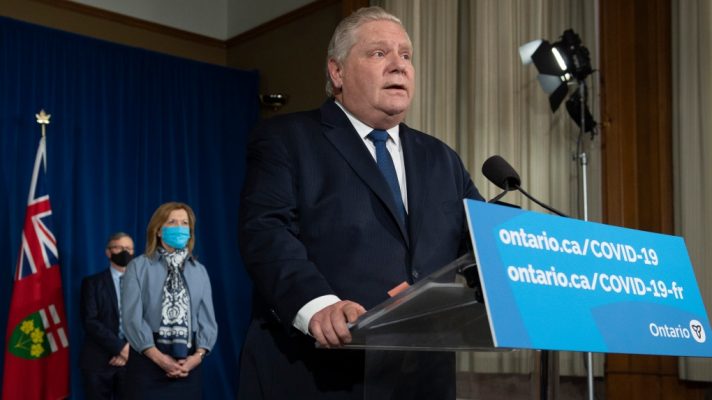
Ontario Premier Doug Ford announcing a state of emergency on Jan. 12, 2021, at Queens Park. Photo by Fran Gunn, The Canadian Press
By Trey Boivin
BELLEVILLE – Now that a Stay-at-Home order has been issued and a declaration of emergency made across Ontario on Jan. 12, 2021, here’s what this means for the average person and how it affects the lockdown that was announced last month.
Some rules of the lockdown changed, and others have stayed the same. The declaration of emergency takes the already existing restrictions of the lockdown and turns them up to 11. Let’s take a closer look.
The Post-Christmas Lockdown
This lockdown was announced on Dec. 21, 2021, but didn’t come into effect until Dec. 26. It was ordered after daily COVID-19 cases in Ontario spiked and had been over 1,000 new cases every day for more than six weeks leading up to the announcement. The Ontario government predicted rates of at least 1,500 cases per day for several more weeks.
Originally, the restrictions would remain in effect until Jan. 23, 2021. However, this has since been extended.
2021 Stay-at-Home
A declaration of emergency was made on Jan. 12 of this year because the province-wide lockdown was not doing enough to stop the spread of COVID-19. The order took effect two days later, on Jan. 14, and is expected to end on Feb. 11, 2021. This is more serious and more extensive than the Post-Christmas lockdown.
General Rules:
Everyone is required to stay at home and should only go out for essential and necessary reasons. Some of these reasons, as listed by the Ontario government, are
- Getting groceries or medication
- Going to medical appointments
- Supporting vulnerable community members or caring for a child
- Attending school
- Going to a bank
- Accessing government services
- Getting exercise or walking pets
- Going to work, if you can’t do it from home.
Businesses:
Stores that primarily sell food and alcohol, pharmacies, social services like addiction rehab, court, and government services are allowed to be open. Restaurants, bars, shopping malls, and general retail stores are not allowed to open. These businesses can operate by delivery or curbside pick up only from 7 a.m. to 8 p.m.
As a general rule, businesses can decide how many people they let in at a time, but it can’t exceed 50 percent of their usual capacity. Although, liquor stores can only use 25 per cent of their regular capacity.
Ceremonies and Celebrations:
Weddings, funerals, and other religious services are allowed as long as everyone follows the physical distancing and face mask rules. However, there can only be a maximum of 10 people indoors or outdoors during these ceremonies.
Schools and Post-Secondary:
Post-secondary institutions must teach virtually unless in-person instruction is required, like the trades or clinical training with physical distancing. Teaching and tests cannot exceed 10 people in a room with limited exceptions for some medical, nursing, and personal support worker students.
Schools that were in grey zones will stay closed until Feb. 10, 2021. It was announced on Wednesday that schools from seven public health units will be returning to in-person classes on Jan. 25.
These seven public health units are:
- Grey Bruce Health Unit
- Haliburton, Kawartha, Pine Ridge District Health Unit
- Hastings and Prince Edward Counties Health Unit
- Kingston, Frontenac and Lennox & Addington Health Unit
- Leeds, Grenville, and Lanark District Health Unit
- Peterborough Public Health
- Renfrew County and District Health Unit
Schools that aren’t under these seven will stay closed until further notice.
Fines:
People and businesses that aren’t following these orders can be legally fined.
The set fines are:
- $750 for people that aren’t following the order
- $1,000 for businesses that are not following the order
- $1,000 for anyone who prevents a police officer from doing their duties to enforce the orders
As always, people are expected to physically distance at least 6 feet (2 metres) apart and wear a mask or face covering where it’s not possible to distance and inside buildings that are open to the public.